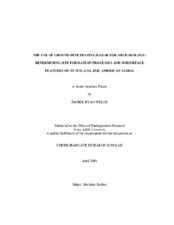| dc.creator | Welch, Daniel | |
| dc.date.accessioned | 2006-07-11T14:19:09Z | |
| dc.date.available | 2006-07-11T14:19:09Z | |
| dc.date.issued | 2006-07-11 | |
| dc.identifier.uri | https://hdl.handle.net/1969.1/3655 | |
| dc.description | Ground-penetrating radar is used to investigate the construction methods of a prehistoric star-shaped mound on Tutuila Island, American Samoa. | en |
| dc.description.abstract | The use of geophysical remote sensing techniques has been increasing for several decades. As this technology becomes increasingly affordable and accurate, more and more archaeologists are beginning to wonder how this emerging technology can complement traditional archaeological techniques. This thesis presents the results of a study using ground-penetrating radar in the mountain settings of American Samoa, a chain of volcanic islands in the South Pacific. Our results show that in American Samoa, ceremonial mound (i.e. star mound) construction details were easily seen in radar profiles. Ground penetrating radar has the potential to yield significant details about such mounds, with no physical impact to the site. | en |
| dc.description.sponsorship | Undergraduate Research Scholars Program | en |
| dc.format.extent | 1317612 bytes | en |
| dc.format.medium | electronic | en |
| dc.format.mimetype | application/pdf | |
| dc.language.iso | | |
| dc.subject | Polynesian archaeology | en |
| dc.subject | Subsurface prospecting | en |
| dc.title | THE USE OF GROUND-PENETRATING RADAR FOR ARCHAEOLOGY: DETERMINING SITE FORMATION PROCESSES AND SUBSURFACE FEATURES ON TUTUILA ISLAND, AMERICAN SAMOA | en |
| dc.type.genre | Thesis | en |
| dc.type.material | text | en |
| dc.format.digitalOrigin | born digital | en |


